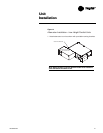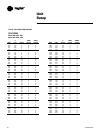
VAV-SVN01E-EN 33
DO NOT SET THIS
POTENTIOMETER
BELOW THE VOLTAGE
OF THE FAN MOTOR.
Max
208 v–
277 v
347 v
120 v
Figure 18 – ECM Control Board
(SCR) Motor Speed Control
Adjustment Procedure.
In order to make units more convenient
and efficient to balance, an SCR
(silicone control rectifier) is provided as
standard on all fan-powered units.
The SCR is located on the side of the
fan control box. To adjust the speed of
the motor, the external knob must be
rotated either clockwise or
counterclockwise depending on the
desired speed adjustment.
There is an internal potentiometer
(Figure 14) setting on the SCR controller
that can be accessed by removing the
control box cover. This internal
potentiometer is set at the factory to the
specific motor voltage.
It may be necessary to adjust this in the
field depending on the building’s power
factor.
NOTE: Do not set this potentiometer
below the voltage of the fan motor.
Figure 17 – Internal Potentiometer
Electrically Commutated Motor (ECM)
Trane offers an energy efficient ECM
motor as a motor option. Balancing of
an ECM motor is accomplished
through electronic control adjustments
on the ECM control board (see Figure
15). Potentiometer settings for a
multitude of CFM settings are given in
Charts 4–15. Other potentiometer
settings can be determined either by
interpolating from these tables or by
using the following equation:
CFMsetting = CFMmin +
{(Potentiometer Setting) x [(CFMmax -
CFMmin)/100]}
There is an LED on the ECM control
board, which will blink one time for
every 100 CFM of motor setting. For
example, the LED on a unit set for 790
CFM will blink 7 times. The LED on a
unit set for 800 CFM will blink 8 times.
NOTE: This feature only verifies that the
CFM is set properly. This feature does
not indicate at what speed the motor is
actually running.
The ECM must be “load tested.” In other
words, the fan must be connected to
properly test the ECM.
Unit
Setup
Figure 16 – SCR
WARNING
WARNING
Hazardous Voltage!
Disconnect all electric power, including
remote disconnects before servicing.
Follow proper lockout/tagout proce-
dures to ensure the power cannot be
inadvertently energized. Failure to
disconnect power before servicing
could result in death or serious injury.


















